Related Research Articles

The Order of the Brothers of the Blessed Virgin Mary of Mount Carmel, known as the Carmelites or sometimes by synecdoche known simply as Carmel, is a Roman Catholic mendicant religious order for men and women. Historical records about its origin remain uncertain, but it was probably founded in the 12th century on Mount Carmel in the Crusader States. Berthold of Calabria, as well as Albert of Vercelli, have traditionally been associated with the founding of the order, but few clear records of early Carmelite history have survived. The order of Carmelite nuns was formalised in 1452.

Teresa of Ávila, OCD, also called Saint Teresa of Jesus, was a Spanish Carmelite nun and prominent Spanish mystic and religious reformer.
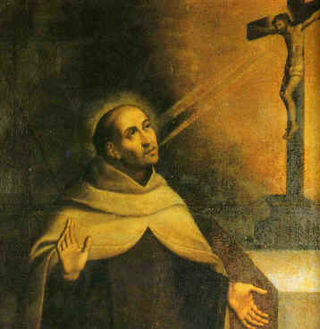
John of the Cross, OCD was a Spanish Catholic priest, mystic, and a Carmelite friar of converso origin. He is a major figure of the Counter-Reformation in Spain, and he is one of the thirty-seven Doctors of the Church.

The Third Order of Our Lady of Mount Carmel, also known as the Lay Carmelites, is a third order of the Carmelite Order of the Ancient Observance, established in 1476 by a bull of Pope Sixtus IV. It is an association of people who choose to live the Gospel in the spirit of the Carmelite Order and under its guidance. Its members are mainly lay people.

Our Lady of Mount Carmel, or Virgin of Carmel, is the title given to the Blessed Virgin Mary in her role as patroness of the Carmelite Order, particularly within the Catholic Church. The first Carmelites were Christian hermits living on Mount Carmel in the Holy Land during the late 12th and early to mid-13th century. They built in the midst of their hermitages a chapel which they dedicated to the Blessed Virgin, whom they conceived of in chivalric terms as the "Lady of the place." Our Lady of Mount Carmel was adopted in the 19th century as the patron saint of Chile.

The Discalced Carmelites, known officially as the Order of the Discalced Brothers of the Blessed Virgin Mary of Mount Carmel or the Order of Discalced Carmelites, is a Catholic mendicant order with roots in the eremitic tradition of the Desert Fathers. The order was established in the 16th century, pursuant to the reform of the Carmelite Order by two Spanish saints, Teresa of Ávila (foundress) and John of the Cross (co-founder). Discalced is derived from Latin, meaning "without shoes".
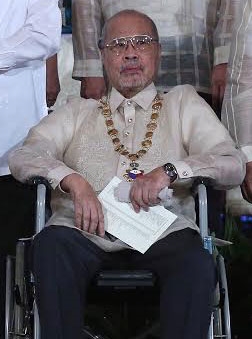
Cirilo F. Bautista was a Filipino poet, critic and writer of nonfiction. A National Artist of the Philippines award was conferred on him in 2014.

Marjorie Evasco is a Filipina poet. She writes in two languages: English and Cebuano-Visayan and is a supporter of women's rights, especially of women writers. Marjorie Evasco is one of the earliest Filipina feminist poets. She is a recipient of the S.E.A. Write Award.
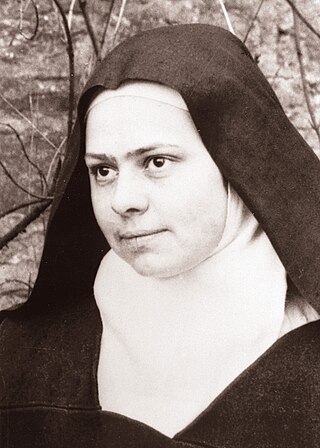
Elizabeth of the Trinity, OCD, born Élisabeth Catez, was a French Discalced Carmelite, a mystic, and a spiritual writer. She was known for the depth of her spiritual growth as a Carmelite as well as bleak periods in which her religious calling was perceived to be unsure according to those around her; she however was acknowledged for her persistence in pursuing the will of God and in devoting herself to the charism of the Carmelites.
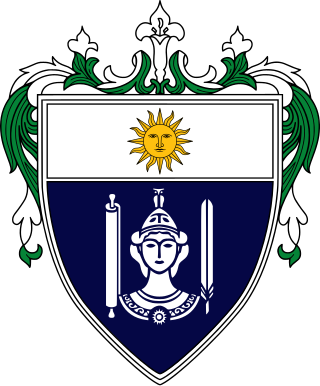
The University of Santo Tomas Faculty of Arts and Letters, popularly known as "UST Artlets" or "UST AB", is the liberal arts school of the University of Santo Tomas, the oldest and the largest Catholic university in Manila, Philippines.

Jerónima de la Asunción, O.S.C. was a Spanish Catholic nun and abbess who founded the Real Monasterio de Santa Clara in Intramuros, Manila, Philippines.
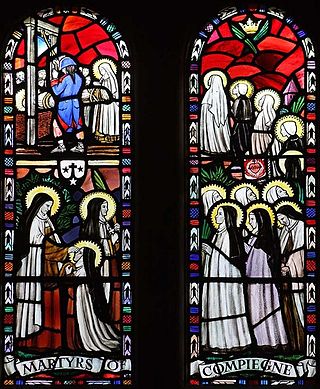
The Martyrs of Compiègne were the 16 members of the Carmel of Compiègne, France: 11 Discalced Carmelite nuns, three lay sisters, and two externs. They were executed by the guillotine towards the end of the Reign of Terror, at what is now the Place de la Nation in Paris on 17 July 1794, and are venerated as beatified martyrs of the Catholic Church. Ten days after their execution, Maximilien Robespierre himself was executed, ending the Reign of Terror. Their story has inspired a novella, a motion picture, a television movie, and an opera, Dialogues of the Carmelites, written by French composer Francis Poulenc.
The Secular Order of Discalced Carmelites, formerly the Secular Order of Discalced Carmelites of the Blessed Virgin Mary of Mount Carmel and of the Holy Mother Saint Teresa of Jesus, is a third order of Catholic lay persons and secular clergy associated with the Discalced Carmelites.
Ligaya G. Tiamson-Rubin, is a multiple Carlos Palanca Memorial Awards for Literature recipient, and currently a professor of the University of the Philippines Diliman. Today, she is teaching Filipino 25, Mga Ideya at Estilo under the Department of Filipino and Philippine Literature at the College of Arts and Letters, University of the Philippines Diliman in Diliman, Quezon City.
When referring to Roman Catholic religious orders, the term Second Order refers to those Orders of cloistered nuns which are a part of the mendicant Orders that developed in the Middle Ages.

María de las Maravillas de Jesús, OCD, in some contexts known as Maravillas de Jesús, was a Spanish Discalced Carmelite. She founded several houses of her order and even set one up in India after serving a brief exile with other Carmelites due to the outbreak of the Spanish Civil War.

The Mount Carmel College of Baler, commonly referred to as MCC Baler or MCCB, is the oldest Catholic mission school in the Philippine province of Aurora. It was founded in 1948 by the American Carmelites, who arrived in Baler upon the invitation of Doña Aurora Aragon-Quezon (1888–1949), former First Lady of the Philippines (1935–1944), wife of the late Philippine Commonwealth President Manuel Luis Quezon, and upon the approval of Alfredo F. Versoza, then bishop of Lipa. It is currently a member of the Catholic Association of Schools in the Prelature of Infanta (CASPI).

Mary Therese Vicente was a Filipino Roman Catholic nun who's service to the Holy Face led her to the foundation of Sisters of the Holy Face of Jesus.

The Santa Teresa de Jesus de Carnideconvent, also known as the Santa Teresa de Jesus of the Order of the Discalced Carmelites and of Santo Alberto convent, is located on the 45 Rua do Norte a Carnide, in the Carnide parish, in Lisbon, Portugal.
Cordelia Chávez Candelaria is an American educator and writer of Hispanic descent.
References
- 1 2 Doyo, Ceres P. "Columnist-turned-cloistered nun continues 'life as prayer and prayer as life'". Inquirer Lifestyle. Archived from the original on 7 November 2014. Retrieved 23 October 2014.
- 1 2 3 4 5 Florentino B. Valeros; Estrellita V. Gruenberg (1999). Filipino Writers in English. Quezon City: New Day Publishers. pp. 59–60. ISBN 971-10-0286-8.
- ↑ Francisco Nemenzo. "Letter from the President: My Student Days". University of the Philippines. Archived from the original on 2010-12-01. Retrieved 2008-03-16.
- ↑ Prof, writer, contemplative nun turns 100
- 1 2 De Joya, Preciosa (2016). "Exorcising Communist Specters and Witch Philosophers: The Struggle for Academic Freedom of 1961". Kritika Kultura. 26: 4–32.